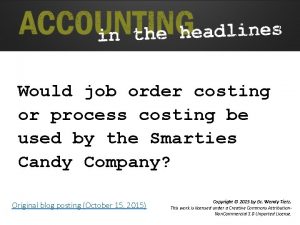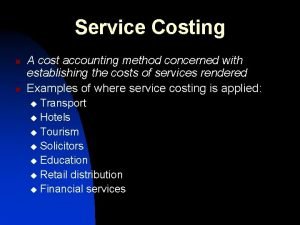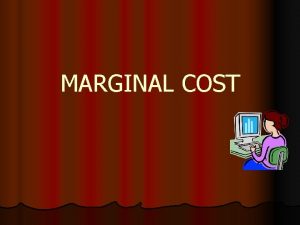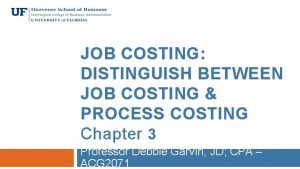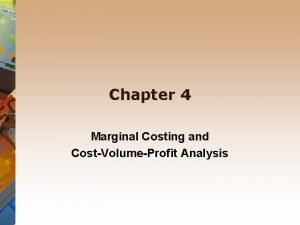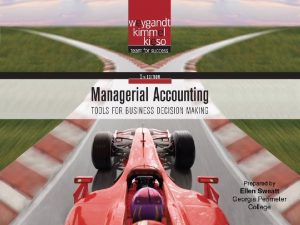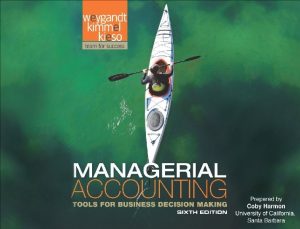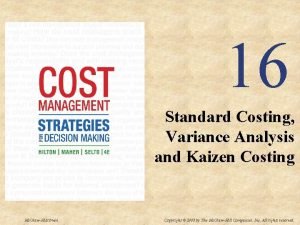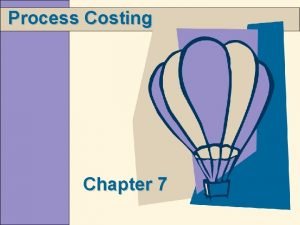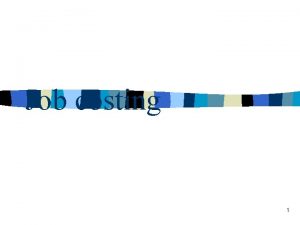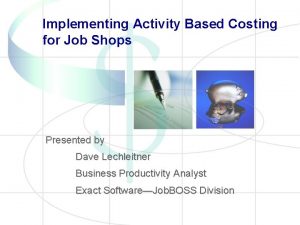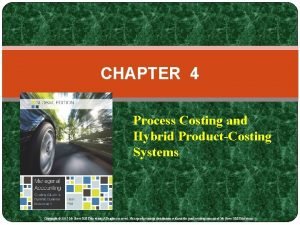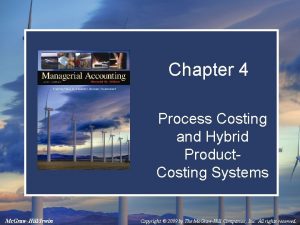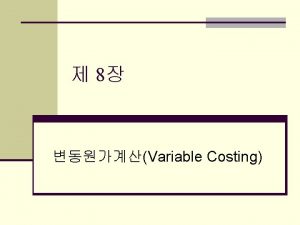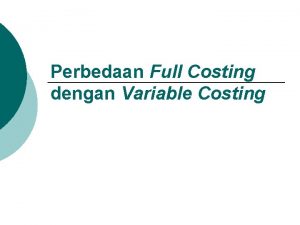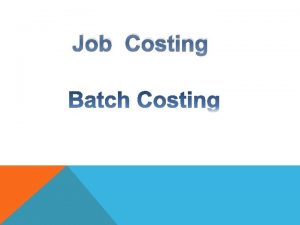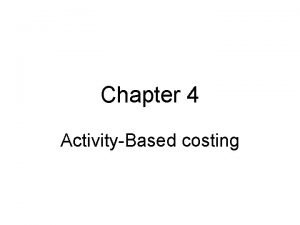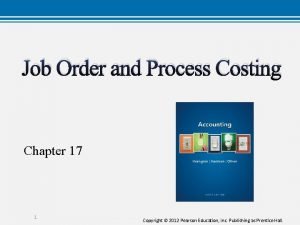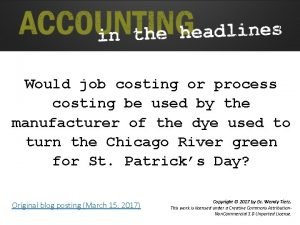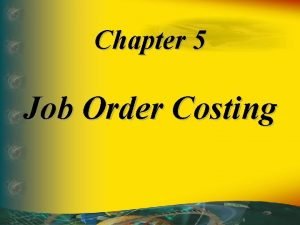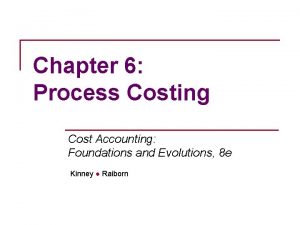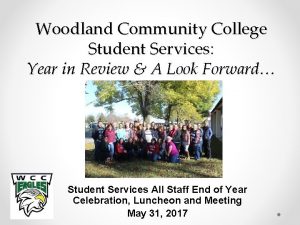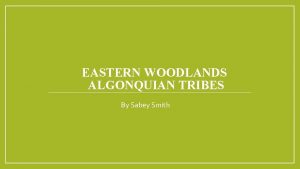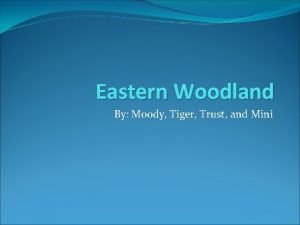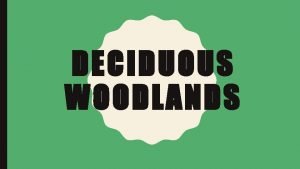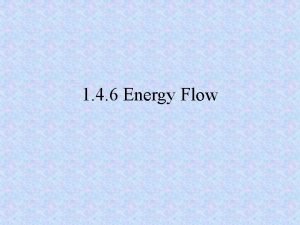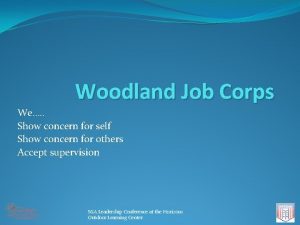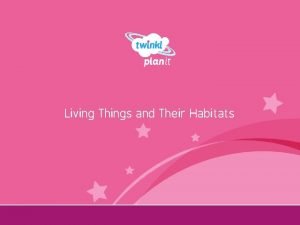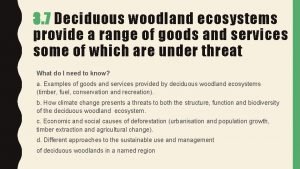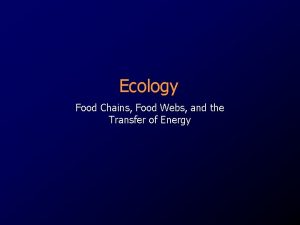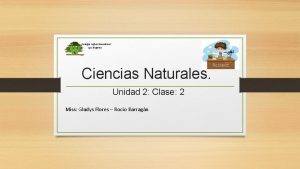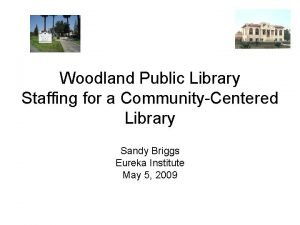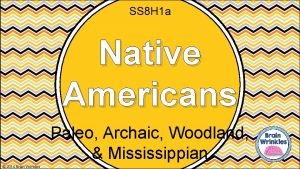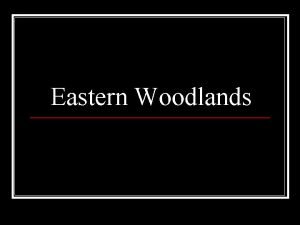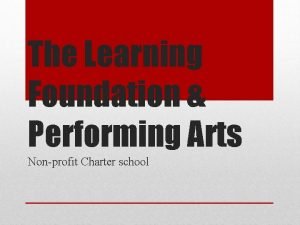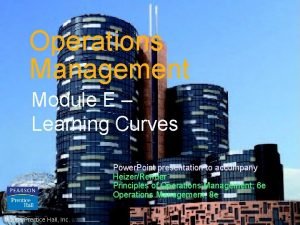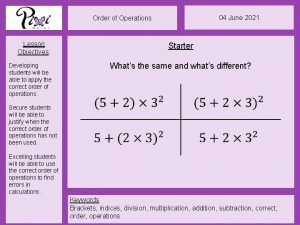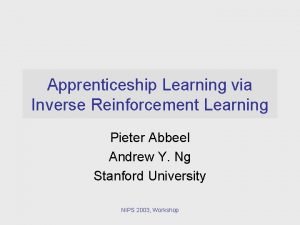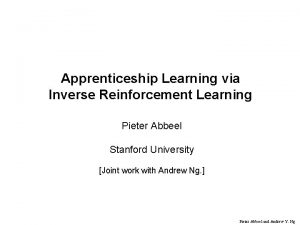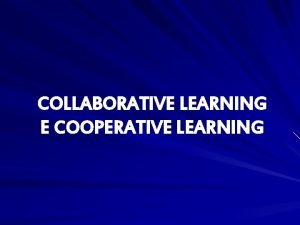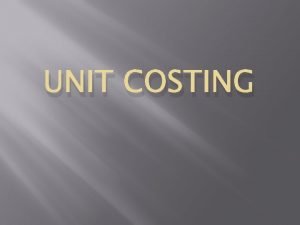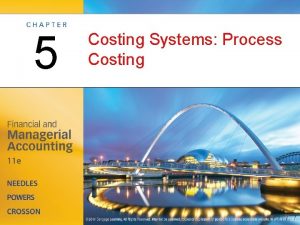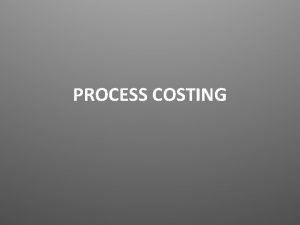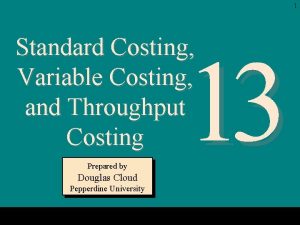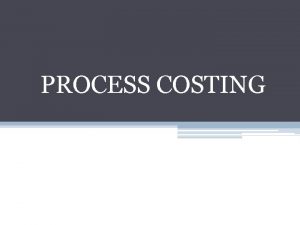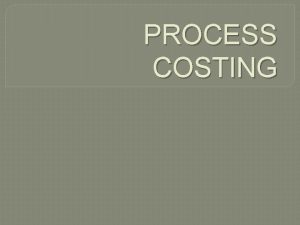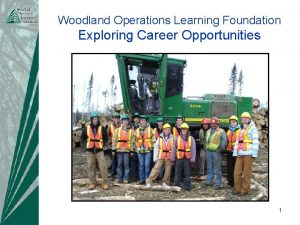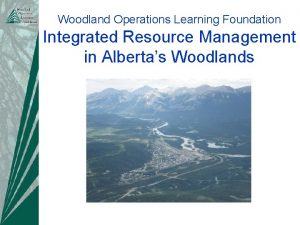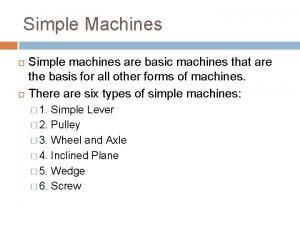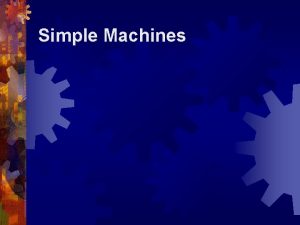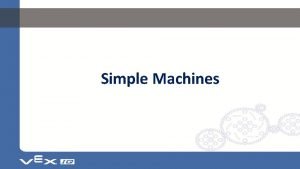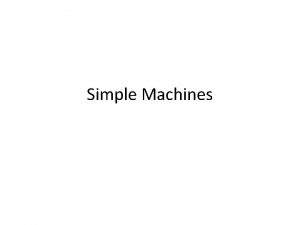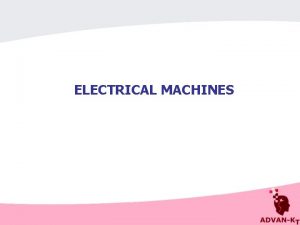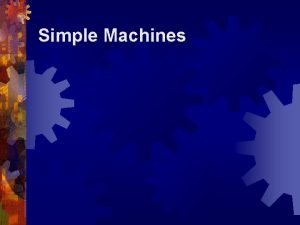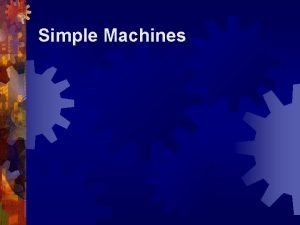Woodland Operations Learning Foundation Woodland Machines Costing 1




















































































- Slides: 84

Woodland Operations Learning Foundation Woodland Machines Costing 1

Course Goal To familiarize the participant with the costs associated with owning and/or operating forestry equipment 2

You will learn to: 1. Understand the factors affecting the forestry equipment profitability 2. Identify the components of ownership cost 3. Define and list overhead costs associated with forestry equipment 4. Identify and describe the components of operating costs 5. Demonstrate the impacts of 4 operating scenarios using the Cost Structure worksheet 3

Chapter 1 You will be able to understand the factors affecting a logging contractor’s profitability including being able to: • Define productivity, utilization and availability • Describe how an operator impacts these three factors (using the ‘Cost Structure’ worksheet) 4

Why become a logging contractor? 1. Turn a dream into reality 2. Desire for independence 3. Build equity in your business 4. Make a profit 5

Becoming a successful logging contractor Why do small businesses fail? • • Managerial incompetence – 45% Unbalanced expertise – 20% Inexperience in management – 18% Inexperience in logging – 9% 6

Becoming a successful logging contractor Focus on understanding costs associated with running a logging business: 1. You will increase your managerial expertise 2. You will increase chances of success and increased profitability 7

Understanding profitability What is profitability? Profit can be defined as: • Monetary gain from a logging business • The amount left over from revenue after all the expenses are paid. Profit = revenues – expenses 8

Availability What is availability? The amount of time the machine is mechanically available for work. • Availability can also be considered a measure of machine reliability. • A key to increasing availability is preventative maintenance. 9

Utilization What is utilization? The amount of time the machine worked compared to the amount of time it was scheduled to work. • Utilization is measured as ‘Scheduled Machine Hours (SMR)’. • Utilization is considered to be a good measure of operational efficiency. 10

Productivity What is productivity? The time the machine is occupied doing productive work. • Productivity is measured as ‘Productive Machine Hours’ (PMH) • As a successful manager you should be considering ‘What is being produced in relation to what is required to be produced? ’ 11

The relationship Cost Factor Hours(h) (%) Total study time 12. 7 100 maintenance 1. 5 12 mechanical 1. 9 15 . 4 3 Availability 11. 2 88 Utilization 8. 9 70 Productive time 8. 9 70 Delay time non-mechanical 12

Profit index In this course we will use a measure of profitability called the ‘Profit Index’ • Use the profit index to judge the impact of decisions a logging contractor might make. • The index is calculated by dividing revenues/benefits by expenses. 13

Monitoring of logging equipment productivity is essential to understand profitability. Monitoring can provide useful information that: • Identify inefficiencies such as idle time and interaction between machines • Identify trends in machine productivity. Is it time to replace the machine? • Support negotiations of logging rates. 14

Cost structure A useful way of managing your cost structure is to break costs out by: • Ownership • Overhead • Operating 15

Chapter 1 review Availability is defined as: The amount of time the machine worked compared to the amount of time it was scheduled to work. True or False 16

Chapter 1 review Availability is defined as: The amount of time the machine worked compared to the amount of time it was scheduled to work. True or False The amount of time the machine was mechanically available for work. 17

Chapter 1 review Productivity is defined as: The amount of time the machine was occupied doing productive work. True or False 18

Chapter 1 review Productivity is defined as: The amount of time the machine was occupied doing productive work. True or False 19

Chapter 1 review A higher profit index indicates a more profitable company. True or False 20

Chapter 1 review A higher profit index indicates a more profitable company. True or False 21

Chapter 1 review It may take a number of years before a new logging contractor realizes a profit. True or False 22

Chapter 1 review It may take a number of years before a new logging contractor realizes a profit. True or False 23

Chapter 1 review A good contractor monitors his costs to: a) Identify inefficiencies such as idle time and interaction between machines b) Identify trends in machine productivity. Is it time to replace the machine? Factors such as fuel consumption and power output are often considered in monitoring productivity. c) Support negotiations of logging rates. d) All of the above. 24

Chapter 1 review A good contractor monitors his costs to: a) Identify inefficiencies such as idle time and interaction between machines b) Identify trends in machine productivity. Is it time to replace the machine? Factors such as fuel consumption and power output are often considered in monitoring productivity. c) Support negotiations of logging rates. d) All of the above 25

Chapter 2 You will learn: 1. Value of a piece of forestry equipment 2. Expected life of a machine 3. Salvage value of a machine 4. Insurance 5. Financing 26

Ownership costs What are ownership costs? Fixed costs associated with the purchase of logging equipment to support your business. • Ownership costs include financing and insurance costs. 27

Valuing logging equipment Selecting the appropriate machinery must be tied to: • Capital Cost • Depreciation Cost • Insurance Cost 28

Valuing logging equipment Selecting the appropriate machinery must be tied to: • The nature of the contract including timber characteristics, weather/climate, season and terrain • The logging system including the other pieces of equipment being used • Availability of the equipment • Support from the manufacturer • Operator ergonomics 29

Replacement Will another year of operating old equipment cost less than the operating cost of a new machine? 30

Replacement When to replace old equipment: • Records indicate that repair is dramatically reducing ‘in-use’ hours (availability) • Loss of productivity • Consideration of new production plans 31

Replacement When to replace old equipment: • Productivity increases are possible through changing technology • A need to ‘standardize’ the piece of equipment with other parts of the logging system • Operator comfort and motivation • Safety concerns 32

Depreciation ‘The cost equal to the reduction in value of a piece of forestry equipment due to usage, passage of time, or wear and tear’ 33

Financing Leasing A financial arrangement whereby one firm buys the equipment for use by another firm. 34

Financing Why Lease? 1. 2. 3. 4. 5. 6. 7. You get most of the benefits of ownership Limited cash outlay; your cash is preserved for other expenses Higher level of financing than a loan; often 100% Equipment is paid for over time with future dollars Makes the replacement of old equipment easier Improves the appearance of your ‘balance sheet’. Debt financing appears on the balance sheet while leasing arrangements do not. Preserves your line-of-credit 35

Borrowing Here are some considerations related to purchasing equipment with a loan: • You will be required to pay the GST up front, • You will generally need around 20% equity or down payment • Security/collateral package associated with loans can be very complicated. • Go easy on borrowing, remember interest payment add to your cash burden 36

Borrowing Preparing to visit your bank: 1. Legal documents concerning the incorporation of your company 2. List of owners, partners, shareholders. 3. Information about existing or pending contracts. 4. List of equipment 5. Financial statements covering the last 3 years 6. Who is your lawyer? Your accountant? 7. Any other information that will help the banker understand your business and 37 the proposal to be financed.

Borrowing Here is what the banker is looking for: 1. Your equity in the company 2. Identified cash flow to service debt 3. Working capital to pay day to day obligations 4. Proven history of earnings 5. Retention of profit in the company 6. Well prepared financial statements 7. Collateral or security 38

Insurance Think of your insurance requirements using a ‘Risk Management’ approach: • Identify risks such as fire, claims from third parties, and theft • Minimize risk • Which of the remaining risks are you prepared to take on • Only purchase insurance for the 39 remaining risk

Insurance Insurers give preference to contractors who: 1. Are profitable 2. Are established and have a good history 3. Have good safety and training programs 4. Run newer equipment 5. Run equipment with Automatic Fire Suppression Systems 6. Have a good claims history 40

Chapter 2 review As a logging contractor it is a good idea to have professionals such as your banker or insurance broker visit your logging operations. True or False 41

Chapter 2 review As a logging contractor it is a good idea to have professionals such as your banker or insurance broker visit your logging operations. True or False 42

Chapter 2 review Insurance companies give preference to logging contractors who are profitable. True or False 43

Chapter 2 review Insurance companies give preference to logging contractors who are profitable. True or False 44

Chapter 2 review Operator safety and comfort are not important considerations when deciding to replace a piece of logging equipment. True or False 45

Chapter 2 review Operator safety and comfort are not important considerations when deciding to replace a piece of logging equipment. True or False Operator safety and comfort are important considerations when deciding to replace a piece of logging equipment. 46

Chapter 2 review ‘Relifing’ is a generally a poor option for equipment replacement when there is faster, more productive equipment available on the market. True or False 47

Chapter 2 review ‘Relifing’ is a generally a poor option for equipment replacement when there is faster, more productive equipment available on the market. True or False 48

Chapter 2 review Purchase of the appropriate logging equipment, at the right time and at the right price is the single most important business decision you will make as a contractor. True or False 49

Chapter 2 review Purchase of the appropriate logging equipment, at the right time and at the right price is the single most important business decision you will make as a contractor. True or False 50

Chapter 3 You will learn to define and list overhead costs associated with forestry equipment. 51

What are overhead costs? Ongoing expense of operating a business, necessary to keep the business functioning but do not necessarily generate a profit Or Cost of resources used in your business just to maintain its existence. 52

Overhead costs Pick-up truck supports: • • Transport of staff Safety Transport of fuel Repair and maintenance 53

Overhead costs Tools • Required to support routine maintenance and repairs 54

Overhead costs Accounting services include: • Bookkeeping including invoicing, tracking and paying expenses, and employee benefits • Reporting to the government (taxes etc) 55

Chapter 3 review What are overhead costs? a) Ongoing expenses of operating a business to keep the business functioning b) Costs of resource used in your business just to maintain its existence. c) Both of the above 56

Chapter 3 review What are overhead costs? a) Ongoing expenses of operating a business to keep the business functioning b) Costs of resource used in your business just to maintain its existence. c) Both of the above 57

Chapter 3 review Overhead costs are important in part because you have to keep paying them even if you have no revenue coming in. True or False 58

Chapter 3 review Overhead costs are important in part because you have to keep paying them even if you have no revenue coming in. True or False 59

Chapter 3 review Tool purchases should be carefully matched to the piece of logging equipment that you are using. True or False 60

Chapter 3 review Tool purchases should be carefully matched to the piece of logging equipment that you are using. True or False 61

Chapter 3 review A pick-up truck is required to: a) b) c) d) go to town for lunch transport fuel bring some firewood home all of the above 62

Chapter 3 review A pick-up truck is required to: a) b) c) d) go to town for lunch transport fuel bring some firewood home all of the above 63

Chapter 4 You will learn to identify and describe the components of operating costs including: • • • Fuel costs Operating supplies Maintenance and Repair Wages Shift length 64

What are operating costs? The regular, usual and customary recurring expenses of operating the logging equipment Or Expenses that vary dependent on the volume of timber logged 65

Repair and maintenance Why is maintenance important to you? • • Increases machine availability Reduces repair costs Increases serviceable life Increases productivity The goal is to maximize ‘up-time’ 66

Tools • The positioning of tools should be carefully considered and matched to the work each employee is expected to undertake. • Should a particular tool be located on the machine, in the pick-up truck, at a mobile repair trailer or back at the shop? 67

Fuel Tips on managing your costs: • Train and educate your operators • Decrease idling • Use a fuel-management systems. Refueling time is not ‘productive’ time. • Up-grade your fleet; consider fuel efficiency when purchasing or replacing equipment. • Follow manufacturer’s specifications for tune-ups and preventative maintenance 68

Training Here are some suggested courses: • Standard First Aid • Workplace Hazardous Material Information System (WHMIS) • Spill Response • H 2 S Alive • Defensive Driving • Chainsaw Safety • Radio Operations 69

Wages should be considered in a broader framework including: • • • Hiring and retention Overtime Working conditions Benefits WCB costs 70

Chapter 4 review The goal of preventative maintenance and repair is maximize ‘up-time’. True or False 71

Chapter 4 review The goal of preventative maintenance and repair is maximize ‘up-time’. True or False 72

Chapter 4 review Costs related to employee benefits can add up to: a) b) c) d) 10% to the cost of wages 40% to the cost of wages 100% to the cost of wages nothing 73

Chapter 4 review Costs related to employee benefits can add up to: a) b) c) d) 10% to the cost of wages 40% to the cost of wages 100% to the cost of wages nothing 74

Chapter 4 review Focused, well timed training for you and your staff can a) reduce overall costs b) meet regulatory requirements c) contribute to the health and safety of you and your staff d) all of the above 75

Chapter 4 review Focused, well timed training for you and your staff can a) reduce overall costs b) meet regulatory requirements c) contribute to the health and safety of you and your staff d) all of the above 76

Chapter 4 review Operating costs are an insignificant part of your overall costs. True or False 77

Chapter 4 review Operating costs are an insignificant part of your overall costs. True or False 78

Chapter 4 review Maintaining a reasonable parts inventory and manage the inventory through the operating season helps to improve logging equipment utilization. True or False 79

Chapter 4 review Maintaining a reasonable parts inventory and manage the inventory through the operating season helps to improve logging equipment utilization. True or False 80

Chapter 5 You will learn to use the Cost Structure worksheet to demonstrate the application of concepts learned in chapters 1 -4. 81

Scenario #2 Using the Cost Structure worksheet, adjust the following costs and determine the overall cost per year increase and the increase in cost/metre. • • Interest rate up 2%, Capital cost up $30, 000, Fuel up $0. 50/l, Machine maintenance up $10, 000 82

Scenario #3 Using the Cost Structure worksheet, adjust the following costs and determine the overall cost per year increase and the increase in cost/metre. • • Interest rate down 1%, Capital cost down $30, 000, , Fuel down $0. 15/l Machine maintenance down $10, 000 83

Scenario #4 Using the Cost Structure worksheet, consider your own circumstances and design your own cost structure work sheet. 84
 Companies that use job order costing
Companies that use job order costing Process costing vs job order costing
Process costing vs job order costing Service costing examples
Service costing examples Absorption costing vs marginal costing
Absorption costing vs marginal costing Job order vs process costing
Job order vs process costing Distinguish between job costing and process costing
Distinguish between job costing and process costing Contract costing meaning
Contract costing meaning Variable costing vs absorption costing
Variable costing vs absorption costing Margin of safety formula business
Margin of safety formula business Total estimated manufacturing overhead is $900 000
Total estimated manufacturing overhead is $900 000 Job costing system vs process costing system
Job costing system vs process costing system Advantages of activity based costing
Advantages of activity based costing Kaizen costing vs standard costing
Kaizen costing vs standard costing Process costing and hybrid product-costing systems
Process costing and hybrid product-costing systems Wip control account
Wip control account Job shop pricing
Job shop pricing Process costing and hybrid product-costing systems
Process costing and hybrid product-costing systems Cost of production report
Cost of production report Mixed cost
Mixed cost Perbedaan full costing dan variable costing
Perbedaan full costing dan variable costing Objectives of job costing
Objectives of job costing Chapter 4 activity-based costing solutions
Chapter 4 activity-based costing solutions Standard costing vs activity based costing
Standard costing vs activity based costing Example of process costing
Example of process costing Metode full costing dan variable costing
Metode full costing dan variable costing Job costing vs process costing
Job costing vs process costing Job order cost accounting
Job order cost accounting Eup in cost accounting
Eup in cost accounting Raft foundation vs pad foundation
Raft foundation vs pad foundation Composition of urine
Composition of urine Cuadro comparativo e-learning y b-learning
Cuadro comparativo e-learning y b-learning Least mean square algorithm in neural network
Least mean square algorithm in neural network Neural networks and learning machines
Neural networks and learning machines Woodland community college counseling
Woodland community college counseling Paleo archaic woodland mississippian
Paleo archaic woodland mississippian Mixed woodland map symbol
Mixed woodland map symbol Sabey eastern washington
Sabey eastern washington Eastern woodland clothing
Eastern woodland clothing Deciduous woodlands
Deciduous woodlands Beussink v woodland
Beussink v woodland Woodland food chain
Woodland food chain Woodland job corps
Woodland job corps Eastern woodland location
Eastern woodland location Woodland habitat classification key
Woodland habitat classification key Woodland habitat classification key
Woodland habitat classification key Paleo archaic woodland mississippian timeline
Paleo archaic woodland mississippian timeline Woodland habitat classification key
Woodland habitat classification key Goyce kakegamic obituary
Goyce kakegamic obituary Eastern woodland tools
Eastern woodland tools Deciduous woodland ecosystem
Deciduous woodland ecosystem Shrubland
Shrubland Colegio woodland los ángeles
Colegio woodland los ángeles Woodland public library
Woodland public library Cirrhosis care near woodland
Cirrhosis care near woodland Paleo archaic woodland mississippian timeline
Paleo archaic woodland mississippian timeline Eastern woodland tribes
Eastern woodland tribes Woodland style art
Woodland style art Colegio ingles woodland
Colegio ingles woodland Lfpa warner
Lfpa warner Mtt teacher training
Mtt teacher training Foundation for learning
Foundation for learning Myerscough college foundation learning
Myerscough college foundation learning Learning curves in operations management
Learning curves in operations management Order of operations learning objectives
Order of operations learning objectives Supervised learning dan unsupervised learning
Supervised learning dan unsupervised learning Concept learning task in machine learning
Concept learning task in machine learning Analytical learning in machine learning
Analytical learning in machine learning Example of non associative learning
Example of non associative learning Difference between lazy learner and eager learner
Difference between lazy learner and eager learner Deductive learning vs inductive learning
Deductive learning vs inductive learning Inductive and analytical learning
Inductive and analytical learning Apprenticeship learning via inverse reinforcement learning
Apprenticeship learning via inverse reinforcement learning Apprenticeship learning via inverse reinforcement learning
Apprenticeship learning via inverse reinforcement learning Inductive vs deductive geometry
Inductive vs deductive geometry Pac learning model in machine learning
Pac learning model in machine learning Supervised data mining
Supervised data mining Pac learning model in machine learning
Pac learning model in machine learning Inductive and analytical learning
Inductive and analytical learning Instance based learning in machine learning
Instance based learning in machine learning Inductive learning machine learning
Inductive learning machine learning First order rule learning in machine learning
First order rule learning in machine learning Collaborative learning vs cooperative learning
Collaborative learning vs cooperative learning Alternative learning system learning strands
Alternative learning system learning strands Active and passive learners
Active and passive learners Multiagent learning using a variable learning rate
Multiagent learning using a variable learning rate
